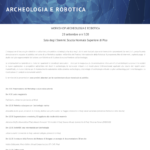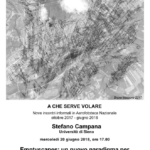The Computer Applications and Quantitative Methods in Archaeology (CAA) Annual Conference is one of the major events in the calendar for scholars, specialists and experts in thefield of computing technologies applied to archaeology.
Emptyscapes project PI will chair the 43rd Computer Applications and Quantitative Methods in Archaeology “KEEP THE REVOLUTION GOING” (CAA 2015 SIENA). The Conference will explore a multitude of topics to showcase ground-breaking technologies and best practice from various archaeological and computer sciences disciplines, with a large diversity of case studies from all over the world. Some of these topics are specific to the Italian scientific community, which played since the early stage of computer application a central role, participating to the debate and development in particular of GIS, databases, semantic, remote sensing, 3D data collection, modeling, visualization, etc.
Within the session on Sites, Landscapes and Survey: The Past, Present and Future of Non-Intrusive Geophysical Survey in the Field and the Laboratory will be presented the state of the art of Emptyscapes project:
Long walks in the italian countryside. Large-scale geophysical prospection in rural and once-urban contexts in central Italy
Abstract – Geophysical prospection has long been recognized as one of the most effective forms of nondestructive archaeological investigation available for use within archaeology. Case studies from throughout the world are increasing in number, leading to a better understanding of the various geophysical methods and of the ways in which they can prove useful for exploratory survey and archaeological interpretation. Despite their wide use in archaeology geophysical methods have for the most part been applied until quite recently in ‘site-based’ projects of investigation.
Technological advances, however, have in the last few years made possible the relatively rapid coverage of wider areas on a ‘landscape’ scale. That said, in the many archaeological projects undertaken each year in Italy, geophysical prospection has for the most part not yet been widely applied as an everyday investigative tool. For that reason the country has produced relatively few case-studies that publicly demonstrate the successful use of geophysical methods, least of all in contexts that encompass areas wider than the individual site or group of sites.
In Italy the potential of geophysical prospection for the large-scale characterization of archaeological contexts, especially in previously unexplored rural or formerly-urban areas, has remained largely unacknowledged or tested in the field.
This contribution, however, will present the first results of a programme of large-scale multi-sensor magnetometry that has covered the whole of the Etruscan and Roman town of Veii, on a now-rural hilltop near Rome, as well as initial exploration of the lowland farming landscape of the Grosseto-Roselle valley in south-western Tuscany. Taken together, these two research projects aim at stimulating changes in the way in which archaeologists in Italy study the archaeology of landscapes, moving whenever the opportunity can be created from an essentially site-based approach to a truly ‘landscape’ perspective.
Despite successful results of small scale geophysical survey, it is difficult to demonstrate the usefulness and reliability in the Italian context without clear supporting evidence. Therefore this kind of investigation, especially if combined with field-walking survey and aerial prospection, along with lidar imaging and test excavation wherever possible, could help to create an entirely new approach to the exploration of previously unconsidered rural and once-urban contexts in Italy and perhaps more broadly throughout the Mediterranean area.
If time allows, a few words will be added about the similar Etruscan and Roman town of Vulci, in northern Lazio, where magnetometry has so far failed to extend understanding of the urban pattern shown with remarkable clarity for parts of the town through aerial photographs from the 1940s onwards. It remains to be seen whether magnetometry, or geophysical prospection of other kinds, can extend the picture of the town’s urban character in the way that has already been demonstrated at Veii.


